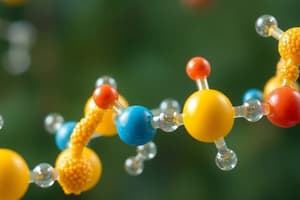Podcast
Questions and Answers
What is the general formula for carbohydrates?
What is the general formula for carbohydrates?
- (CH2O)n (correct)
- (CH3)n
- (C2H4O2)n
- (C6H12O6)n
Which type of carbohydrate is composed of two monosaccharides?
Which type of carbohydrate is composed of two monosaccharides?
- Monosaccharide
- Polysaccharide
- Disaccharide (correct)
- Oligosaccharide
In the structure of carbohydrates, what is the ratio of Carbon to Hydrogen to Oxygen?
In the structure of carbohydrates, what is the ratio of Carbon to Hydrogen to Oxygen?
- 1:1:1
- 2:1:1
- 1:2:1 (correct)
- 1:2:2
Which of the following is a monosaccharide?
Which of the following is a monosaccharide?
What process involves breaking down a disaccharide into two monosaccharides?
What process involves breaking down a disaccharide into two monosaccharides?
What results from the dehydration synthesis of two glucose molecules?
What results from the dehydration synthesis of two glucose molecules?
What is true about structural isomers of hexose monosaccharides?
What is true about structural isomers of hexose monosaccharides?
Which of the following is NOT classified as a carbohydrate?
Which of the following is NOT classified as a carbohydrate?
What are the two types of glycosidic bonds present in starch?
What are the two types of glycosidic bonds present in starch?
Which polysaccharide is known for its unbranched structure and is primarily found in the plant cell wall?
Which polysaccharide is known for its unbranched structure and is primarily found in the plant cell wall?
Which type of fat is defined as having a carbon-carbon double bond?
Which type of fat is defined as having a carbon-carbon double bond?
What structural characteristic differentiates cis-fatty acids from trans-fatty acids?
What structural characteristic differentiates cis-fatty acids from trans-fatty acids?
Which molecule acts as a storage form of glucose in animals?
Which molecule acts as a storage form of glucose in animals?
Which type of fatty acid contains no carbon-carbon double bonds?
Which type of fatty acid contains no carbon-carbon double bonds?
What is the main component of triglycerides?
What is the main component of triglycerides?
How do trans-fats generally affect human health?
How do trans-fats generally affect human health?
Flashcards are hidden until you start studying
Study Notes
Organic Compounds
- Organic compounds are carbon-containing, covalently bonded compounds in the body.
- Include four major classes of macromolecules: carbohydrates, lipids, proteins, and nucleic acids.
- Macromolecules are composed of smaller subunits known as monomers, linked by covalent bonds to form polymers.
Carbohydrates
- Found in grains, fruits, and vegetables; provide energy in the form of glucose.
- General formula: (CH₂O)n, with a carbon:hydrogen:oxygen ratio of 1:2:1.
- Three main subtypes: monosaccharides, disaccharides, and polysaccharides.
Monosaccharides
- Simple sugars with a single chain or ring structure.
- Examples include glucose (energy source), galactose (part of lactose), and fructose (part of sucrose).
Disaccharides
- Formed from two monosaccharides through dehydration synthesis, resulting in a covalent bond.
- Common disaccharides include maltose (grain sugar), lactose (milk sugar), and sucrose (table sugar).
- Hydrolysis is the process of breaking down disaccharides back into monosaccharides using water.
Polysaccharides
- Long branching chains of simple sugars; include starch (plant storage) and glycogen (animal storage).
- Starch has two components: amylose (unbranched, α 1-4 glycosidic bonds) and amylopectin (branched with α 1-4 and α 1-6 glycosidic bonds).
- Cellulose is a polysaccharide in plant cell walls, consisting of glucose monomers linked by β 1-4 glycosidic linkages, resulting in a fibrous structure.
Lipids
- Organic compounds comprised of carbon and hydrogen atoms.
- Triglycerides (neutral fats) consist of glycerol and fatty acid chains.
- Fats can be saturated (no double bonds, solid at room temperature) or unsaturated (at least one double bond, typically liquid at room temperature).
Saturated vs. Unsaturated Fatty Acids
- Saturated acids (e.g., stearic acid) pack tightly, can contribute to cardiovascular disease, and should be limited in the diet.
- Unsaturated fatty acids categorize into monounsaturated (one double bond) and polyunsaturated (multiple double bonds); generally liquid at room temperature.
Trans-Fats
- Formed from unsaturated fats with double bonds in either cis (same side) or trans (opposite side) configurations.
- Cis configuration leads to a kink in the chain, preventing tight packing; trans configuration allows for tighter packing.
- Trans-fats can negatively impact health, increasing LDL cholesterol levels in humans.
Studying That Suits You
Use AI to generate personalized quizzes and flashcards to suit your learning preferences.



